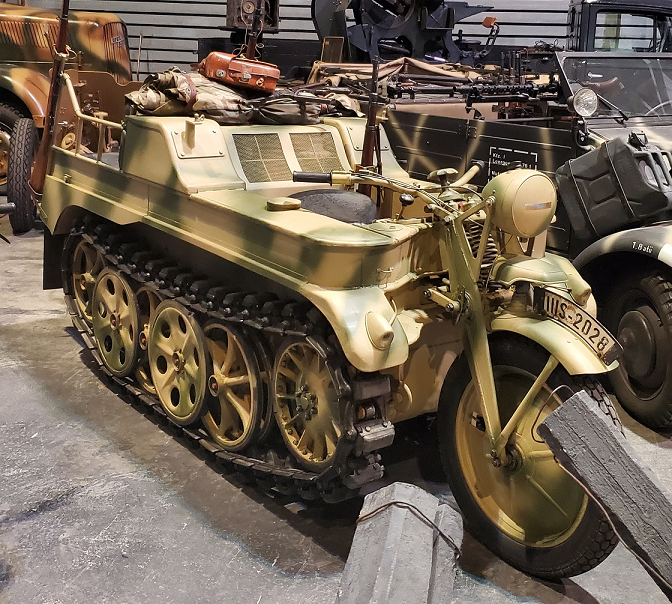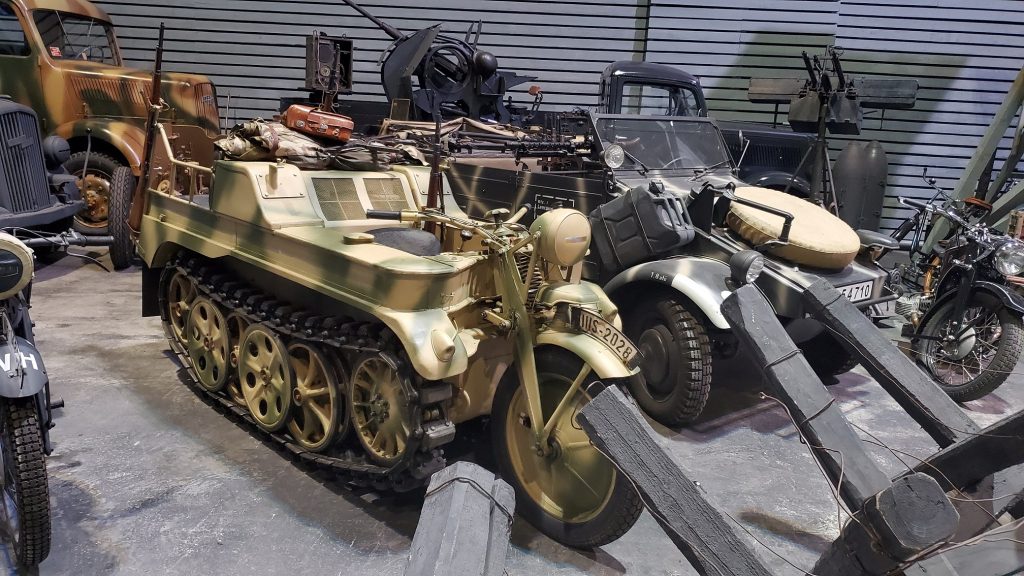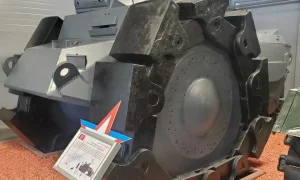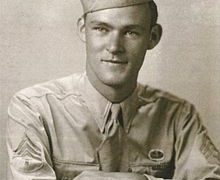Kettenkrad- Half-track Motorcycle German Wonder
Kettenkrad Half Track at St.Pete Museum
Kettenkrad Creation and Production
Sd.Kfz.2 (Sonderkraftfahrzeug 2), also known as Kettenkrad HK 101, is a high-traffic half-track motorcycle developed and mass-produced in Germany during World War II. It was developed for use in the airborne and mountain infantry divisions of the Air Force and ground forces of Nazi Germany, however, due to its high dynamic characteristics, it gained great popularity in the German army and was widely used by all its units. In total from 1940 to 1945, 8871 motorcycles were produced. After the end of the war, about 550 more vehicles were assembled from the remaining stock of parts during the period, which were used in agriculture, forestry, etc. until the 1950s.
In 1940, NSU Motorenwerke received an order from the Ministry of Armaments of the Third Reich to develop a light half-track tractor with a payload of 500 kg. Such a machine was required primarily by parachute and mountain infantry units as a light artillery tractor, since it was impossible to transport the equipment already available on board the main Junkers 52 / 3M military transport aircraft. I must say that the layout of the half-track tractor has been more or less widely used since the First World War., but the NSU designers used a rather bold technical solution. The new tractor they created in a few months was radically different from everything that had been produced in the world before, and visually resembled a hybrid of a tractor and a motorcycle. This similarity was due to the car’s nickname Kettenkrad, under which it became widely known.Officially, the new tractor was called Kleines Kettenkraftrad Typ HK 101 and passed through the index of military equipment designations of the German army as Sd.Kfz.2
Interestingly, one of the main developers of the new car was Heinrich Ernst Knipkamp, later known as the creator of the undercarriage of the Tiger and Panther tanks, as well as the Sd.Kfz armored personnel carrier. 250and those like him. The concept of a half-track motorcycle was developed and patented by Kniepkamp in the summer of 1939. He equipped the new machine with a chassis of his own design, a characteristic feature of which was the staggered arrangement of road wheels.
The turning of the car was carried out mainly through the Cletrac active differential, the brakes of which were cross-linked with the steering wheel fork. The motorcycle-type steering wheel itself served more as an auxiliary function of a visual marker of the direction of movement. In addition to the driver, Kettenkrad could take on board two more people, the total load capacity was 325 kilograms, which quite satisfied the needs of the military, since the Kettenkrad was able to tow heavier loads.
The first tests of the SdKfz 2 took place at the end of 1940. Their results were highly appreciated, and the new tractor was put into service, after which the deployment of mass production began. Until the end of 1940, the first 142 copies of Kleines Kettenkraftrad Typ HK 101 were produced. For the first three years, tractors were produced in relatively small quantities, but the growing popularity of the machine led to the fact that already in 1943 its annual output exceeded 2500. In the same year, production Sd.Kfz. 2 Stoewer joined. In total, 8871 tractors of this type were produced until the end of the war, of which Stoewer accounted for about 1300 units. At the end of the war, from the remaining backlogs of hulls and other parts, the same firms produced about 550 more Kettenkrads, however, now as light agricultural tractors. Finally, the production of these machines ceased only in 1949. In addition, in the second half of the 1940s, the French company Babiolle converted a number of captured Kettenkrad into ordinary tractors (the control post was moved back, the front wheel was dismantled).
Back in 1943, as a further development of the NK-101, NSU developed the NK-102 heavy half-track motorcycle with a more powerful engine and five seats, but it was not adopted by the Wehrmacht.
Kettenkrad Modifications
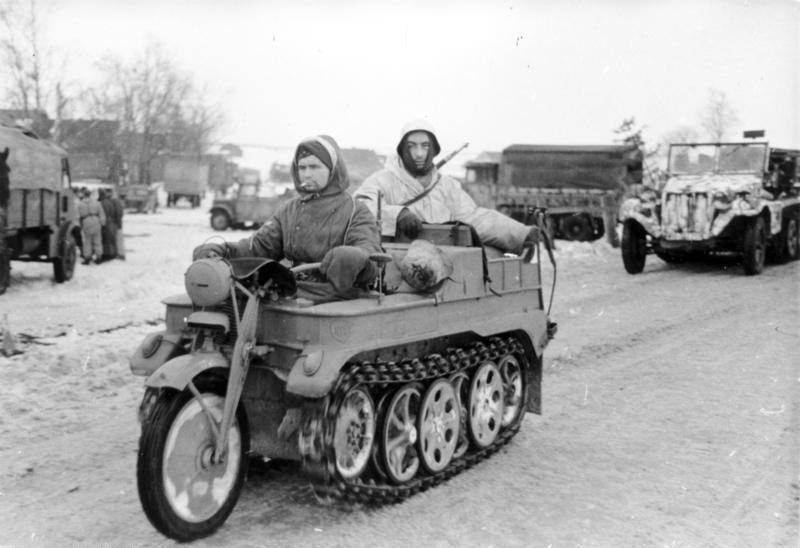
Kettenkrad on Eastern Front
Specifications
- Weight 1230 kg
- Crew 2-3 people
- Load capacity 350 kg
- Engine 4-cylinder, carburetor – Opel Olimpia 1.5l
- Engine power 36 hp
- Gearbox three-speed
- Highway speed up to 61.5 km/h
- Cruising range on the highway 260 km
- Fuel capacity 42 l
- Track width 170 mm
Kettenkrad Use
During the tests, it turned out that this motorcycle can be successfully used as a towing vehicle not only for light artillery guns, but also for aircraft, as well as as a cable layer.
The NSU half-track motorcycle, designed as a light tractor for mountain rifle troops, quickly found use in all types of German armed forces, where it was used to tow light mountain and anti-aircraft guns, mortars, aircraft, reels of telephone cable and various kinds of trailers.
In addition, the standard factory kit included hinged armor, after which the tractor turned into a half-track armored vehicle armed with a machine gun.
In the post-war years, this machine was used for a long time in agriculture and forestry, as well as in the postal service in the highlands.
Machine evaluation
Judging by the reviews of the Wehrmacht soldiers, this machine was indispensable in the USSR in the cold season, as well as in the autumn and spring thaws.
In popular culture
- In the feature film Saving Private Ryan, a captured Sd.Kfz. 2 is used in the bridge defense scenes, where it appears as a light reconnaissance vehicle.
- In the film Zvezda, a Soviet reconnaissance group during a skirmish with a German patrol moving on Sd.Kfz. 2, as a result of shelling loses the radio.
- In the manga and anime of the same name, Shoujo Shuumatsu Ryokou, the main characters travel in a modified Sd.Kfz.2
- In the feature film “Stalingrad” in one of the fragments, a German captain (Thomas Kretschmann) drives a Sd.Kfz.2
- In the computer games “Battlefield 1942 “, “Battlefield V “, “Heroes & Generals”, “Company of Heroes “, in particular, machines of the Sd.Kfz type are used. 2.


